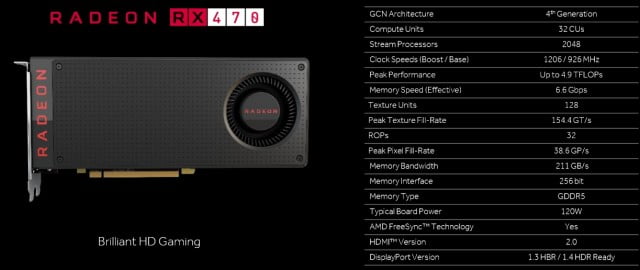
In late June, AMD launched its new RX 480, a midrange $200 — $240 GPU with both 8GB and 4GB RAM loadouts. Today, the company is taking the lid off its entry-level follow-ups: The RX 470 and RX 460. These GPUs will target the $150 and $100 price brackets, respectively, and complete AMD’s Polaris refresh cycle (as far as we know, anyway).
When AMD announced Polaris, it made a number of claims about delivering up to 2.8x improved performance-per-watt. The RX 480 was a huge leap over its predecessors, but its performance per watt was only about 1.73x better than the R9 270X. The RX 470 is the GPU AMD claims will actually deliver on its previous power promise.

With a cut-down number of compute cores, lower RAM clock, and lower base frequency, the RX 470 could potentially deliver the efficiency gains AMD is targeting, while still substantially outperforming the old R9 270X. The 270X has 1,280 cores, 80 texture units, and 32 ROPS, while the RX 470 has 2,048 compute cores, 128 texture units, and 32 ROPS — a substantial increase on all fronts. Board memory bandwidth is 18% higher and AMD’s improved delta color compression should further boost performance.
In many ways, the RX 460 looks a lot like the HD 7970 / R9 280X that AMD launched some 4.5 years ago. Base clocks are similar, as is the allocation of texture units and ROPs — though the RX 470 has more RAM (4GB, up from 3GB), less memory bandwidth though higher overall memory efficiency, and the additional performance uplift baked into Polaris. It also starts at $150, while the HD 7970 was a $550 card on launch day. It’d be interesting to pit these two against each other and see which comes out on top. At $149, the RX 470 sits at the top of the GTX 950 range, but a bit below the GTX 960 (GTX 960 cards currently start around $169 on Newegg).
The RX 460: Enter the entry-level
The RX 460 is AMD’s new budget entry GPU based on its Polaris 11 core (RX 480 and RX 470 are built on Polaris 10). This GPU packs 896 cores, a maximum 1.2GHz frequency, 48 TMUs, and 16 ROPS. It’s meant to compete against the old R7 260X, a GCN 1.1 GPU with an 896:56:16 configuration and a 1.1GHz base clock speed.

AMD is predicting performance gains of 20-30% for the RX 460 as compared with the older R7 260X, and that seems in-line with what the company has previously said about Polaris’ efficiency as compared with previous-generation hardware. At $100, the RX 460 will compete against the GTX 750 Ti — the GTX 950 starts at $132 according to Newegg, and that’s a non-trivial price difference for this cost bracket.
Overall, these new cards should be solid upgrades over AMD’s earlier GCN products and could give the company an advantage in the entry and lower-midrange markets. Nvidia will undoubtedly answer in time, but we’d expect Team Green to answer with price cuts on the GTX 950 and 960 (if required) as opposed to launching another Pascal variant so quickly. $100 is probably the floor for Polaris’ introduction; cards below that price point are often refurbs or based on old architectures. APUs and integrated graphics have largely eaten the sub-$100 market.
AMD’s board power ratings should keep both the RX 460 and RX 470 from running into the power problem that hit the RX 480 at launch. The RX 470’s 120W rating means it’ll be capable of running off a single PCI Express six-pin connector without issue, while the RX 460’s situation is less clear. With a listed board power of under 75W, some AIBs could still choose to ship with a PCI Express six-pin, while others might not.
[Source:- Extreme tech]





